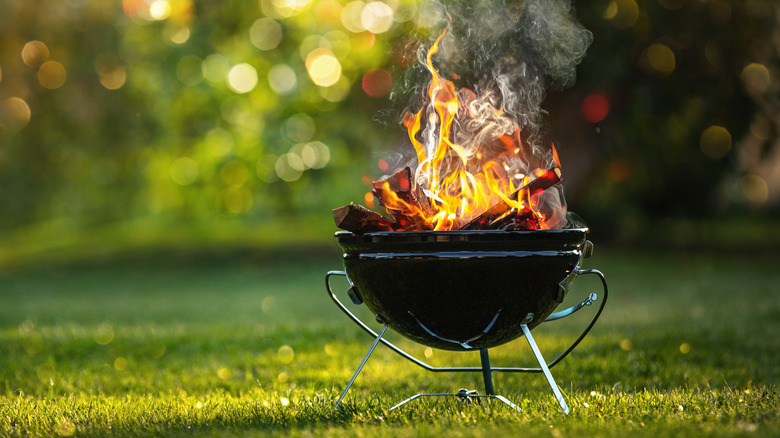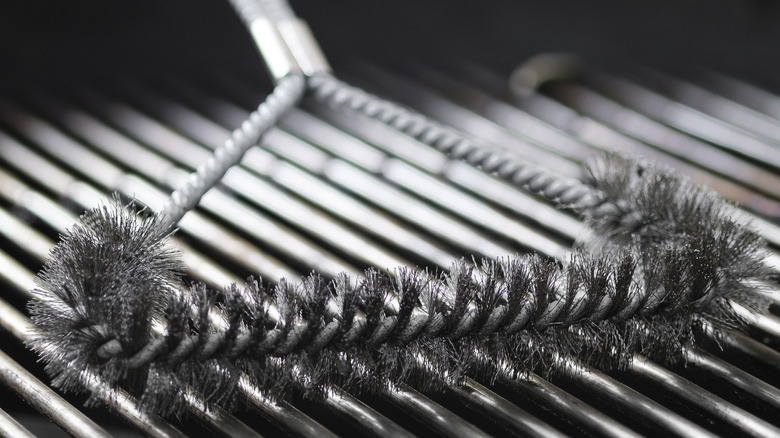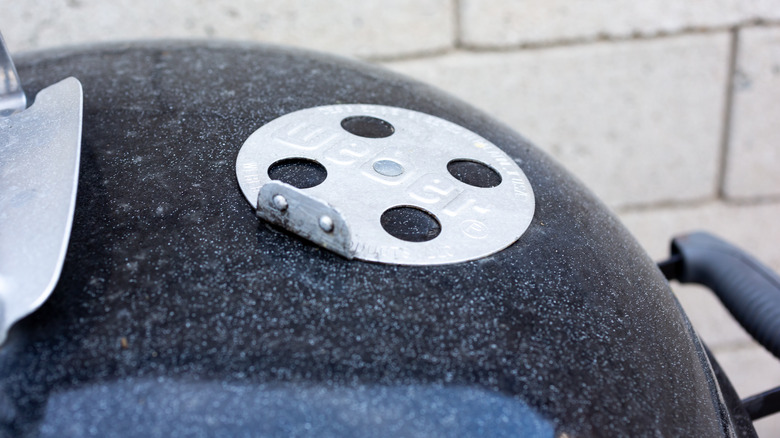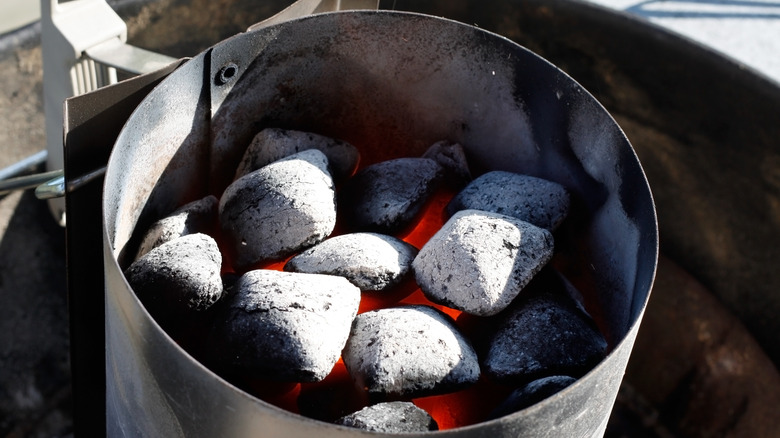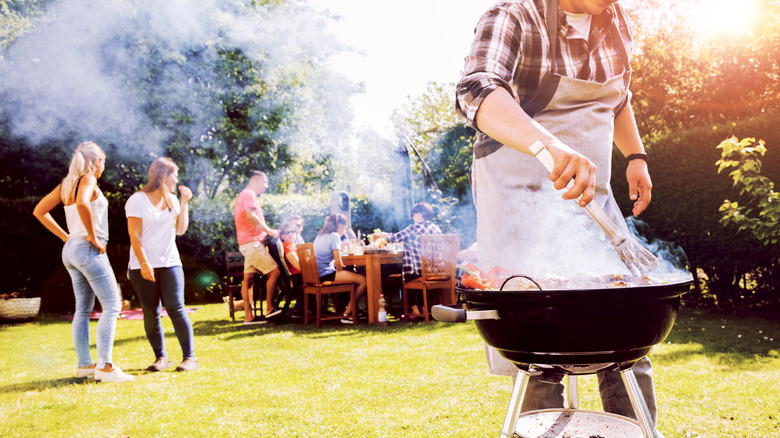Mistakes Everyone Makes With A Charcoal Grill, According To A Grillmaster
While some backyard barbecuers prefer a gas grill with all the bells and whistles, some prefer a good old-fashioned charcoal grill. Taste of Home admits that cooking with gas does have its perks in that gas grills heat up much more quickly, are easier to clean, and are more environmentally friendly, but you just can't beat that deep, smoky flavor you can only get from grilling over coal. What's more, charcoal grills tend to be a lot cheaper than gas ones — plus, it's reassuring to know with a charcoal grill there's no need to keep any of those scary propane cylinders in the yard. According to the Fireman's Association of the State of New York, while both gas grills and charcoal ones pose fire risks, propane provides the added danger of explosion should the tank get too hot or spring a leak.
If you're grilling with charcoal, safety should still be your first concern, but you'll also want to make sure your food comes off the grill as tasty as possible. Otherwise, why go through all that work instead of just throwing those steaks in a pan? In order to help you maximize your grilling success, Mashed called upon the expertise of Dustin Green, a grillmaster at Weber Grills. Green kindly shared with us some of the biggest mistakes people make with their charcoal grills as well as some tips on how you should be grilling instead.
Failing to prepare the grill
Every time you wheel out the grill, Green said you should take the time to both preheat and clean it — and in just that order, too. He advised heating up the grill, lid closed, for at least 10 minutes (though you can go up to 15), and making sure that both the top and bottom vents are open all the way as you do so. "This high heat," he told Mashed, "will loosen any pieces of food left behind on the grate, making it easy to clean them off with your grill brush."
So yes, once the grill's properly preheated, you'll need to get out the grill brush and give the grates a good scrubbing before throwing on the meat. Getting the crud off helps to keep your meat or veggies from sticking, as does the preheating process itself. Another benefit of taking the time to preheat, according to Green, is that it "gets the grate hot enough to sear properly." While you're waiting for the grill to preheat, you can always use the time to prep whatever you'll be grilling or else get the sides ready — you know, open a bag of chips, make sure the beer and soda's ice cold, find a bottle opener, and all those other thoughtful little details that make a backyard barbecue so successful.
Leaving the grill vents closed
When you're preheating the grill, you'll have the vents open, but remember to check them once you start cooking. Green explained that those dampers on the top and bottom of a charcoal grill are there to control the airflow inside. He cautioned that "the more air flowing into the grill, the hotter the fire will grow and the more frequently you will have to replenish your coals." In order to slow the burn rate down, he said you can close the top vent up to halfway, although the bottom vent should remain fully open.
Whatever you do, though, do not forget to open the grill vents at all! "Leaving the vents closed," Green told us, "will cut off the oxygen needed to fuel the fire." If you close up the bottom vent in particular, this may put the fire out altogether. If you're wondering why your grill won't stay lit and your meat never cooks, the bottom grill vent should be the first thing you check.
Not waiting until the coals ash over
Even if you have properly preheated your grill, you may not be ready to throw on the steaks just yet. Green said, "If you see smoke, the charcoal isn't ready." He does have a suggestion for the best way to get your coals burning quickly and evenly, and that is to use what is known as a chimney starter. You should be able to buy one of these anywhere grilling supplies are sold, or you can even make one yourself by removing both the top and bottom from a large metal can (like a gallon-sized paint can), drilling holes around the bottom, then attaching a handle of some sort to the top (Instructables provides a handy tutorial).
In order to use the chimney starter to get your charcoal grill going, all you need to do is fill the chimney starter with coals, then light two coals right on the grill grates. Place the chimney starter on top of the burning coals, and the heat should spread from the bottom of the "chimney" right up to the top in about 10 to 15 minutes. As Green told us, "You'll know the coals are ready when the ones on top have started to turn gray with ash."
Checking the grill again and again
Cooking, whether outdoors or in, can be a tricky proposition. Unless you're using a slow cooker, you never want to "set it and forget it." At worst, this can be dangerous (especially if you're cooking with fire), and at best, you're likely to wind up with food that's overcooked and dry if not downright charred. Still, no matter how hands-on a cook you are, there comes a time when you just have to let your food alone without checking up on it every few seconds. As you should know by now, opening the oven door when you're baking a cake results in heat loss that won't do the cake much good. Well, as Green told us, it works much the same way when you're cooking meat on the grill.
"It's important to keep your grill lid closed as much as possible," he explained. "With the lid on, the grates remain hot enough for searing, preventing food from drying out." He also said that the grill lid serves the purpose of trapping smoke inside as well as reducing the amount of oxygen inside the grill, something that will help to prevent any dangerous flare-ups when melting fat hits flame. One more reason for keeping a lid on things, according to Green: "Keeping the lid closed will speed up cooking, allowing you to get dinner on the table faster."
